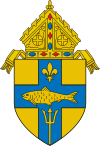
The Roman Catholic Archdiocese of Indianapolis is a division of the Roman Catholic Church in the United States. When it was originally erected as the Diocese of Vincennes on May 6, 1834, it encompassed all of Indiana as well as the eastern third of Illinois. It was renamed the Diocese of Indianapolis on March 28, 1898. Bishop Francis Silas Chatard, who had been living in Indianapolis since 1878 when he was appointed Bishop of Vincennes, became the first Bishop of Indianapolis. It was elevated from a diocese to a metropolitan archdiocese on October 21, 1944.
Lilly Endowment Inc., headquartered in Indianapolis, Indiana, is one of the world's largest private philanthropic foundations and among the largest endowments in the United States. It was founded in 1937 by Josiah K. Lilly Sr. and his sons, Eli Jr. and Josiah Jr. (Joe), with an initial gift of Eli Lilly and Company stock valued at $280,000 USD. As of 2020, its total assets were worth $21 billion.

The history of Indianapolis spans three centuries. Founded in 1820, the area where the city now stands was originally home to the Lenape. In 1821, a small settlement on the west fork of the White River at the mouth of Fall Creek became the county seat of Marion County, and the state capital of Indiana, effective January 1, 1825. Initially the availability of federal lands for purchase in central Indiana made it attractive to the new settlement; the first European Americans to permanently settle in the area arrived around 1819 or early 1820. In its early years, most of the new arrivals to Indianapolis were Europeans and Americans with European ancestry, but later the city attracted other ethnic groups. The city's growth was encouraged by its geographic location, 2 miles (3.2 km) northwest of the state's geographic center. In addition to its designation as a seat of government, Indianapolis's flat, fertile soil, and central location within Indiana and the Midwest, helped it become an early agricultural center. Its proximity to the White River, which provided power for the town's early mills in the 1820s and 1830s, and the arrival of the railroads, beginning in 1847, established Indianapolis as a manufacturing hub and a transportation center for freight and passenger service. An expanding network of roads, beginning with the early National Road and the Michigan Road, among other routes, connected Indianapolis to other major cities.
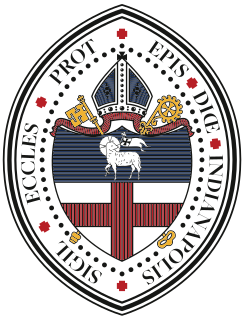
The Episcopal Diocese of Indianapolis, formerly known as the Episcopal Diocese of Indiana, is a diocese in Province V of the Episcopal Church. It encompasses the southern two-thirds of the state of Indiana. Its see is in Indianapolis, Indiana, at Christ Church Cathedral. According to the diocesan newsletter, the diocese has 10,137 communicants in 49 parishes. The current bishop is Jennifer Baskerville-Burrows, the first African-American woman to serve as diocesan bishop in the Episcopal Church and the first woman to succeed another woman as a diocesan bishop in the Episcopal Church; Catherine Waynick served as bishop of the diocese from 1997 to 2017.

Lockerbie Square Historic District is a national historic district on the National Register of Historic Places within Indianapolis, Indiana, listed on February 23, 1973, with a boundary increase on July 28, 1987. It is noted for its Federal, Italianate, and Queen Anne style architecture. The original platting of Lockerbie Square, done by Jannett Smith Lockerbie McOuat and named for her father, Scottish immigrant George Murray Lockerbie, was between 1847 and 1850. The 1960s saw an immense effort to save the buildings within the district, becoming the first historic district in Indianapolis. Many of the buildings date from 1855 to 1930. James Whitcomb Riley, famed Hoosier poet, lived in the district for over two decades. He was known to give candy to local children on his regular walks.

Christ Church Cathedral is the cathedral for the Episcopal Diocese of Indianapolis. Christ Church parish was formally organized in 1837. The present-day church building was erected in 1857 on Monument Circle at the center of downtown Indianapolis to replace the parish's first church built on the same site. Designed by architect William Tinsley, the English Gothic Revival-style structure is the oldest church building in Indianapolis and Marion County, Indiana, that has remained in continuous use. It is also the oldest building on Monument Circle. Christ Church is known for its music, especially its pipe organs, one of which was donated by Ruth Lilly, and its professional Choir of Men and Boys and Girls' Choir. The parish is also known for its community service, including an annual strawberry festival fundraiser and other charitable work. Christ Church Cathedral was added to the National Register of Historic Places on July 10, 1973. It is located in the Washington Street-Monument Circle Historic District.

Bohlen, Meyer, Gibson and Associates, or BMG, is an architectural firm based in Indianapolis, Indiana. It was founded in Indianapolis on April 10, 1853, as D. A. Bohlen, Architect by Diedrich A. Bohlen, German immigrant. In 1884, after Diedrich's son, Oscar D. Bohlen, joined the firm it was renamed D. A. Bohlen and Son. Four successive generations of Bohlen architects have worked at the firm: Diedrich A. Bohlen, Oscar D. Bohlen, August C. Bohlen, and Robert L. Bohlen. The firm specialized in institutional projects, especially civic, religious, and educational buildings. In 1971 Melvin B. G. Meyer acquired majority interest in the firm, which adopted its name in reference to its founder and its two principal architects, Meyer and John M. Gibson. The architectural firm is among the oldest still operating in the United States. More than twenty of its projects are listed on the National Register of Historic Places.

The Episcopal Church of All Saints serves the Old Northside Historic District near downtown Indianapolis. It is distinctive within the diocese for its Anglo-Catholic style of worship, and is historically significant as the first Episcopal Church in the United States to regularly ordain a woman as priest. The building also served as the cathedral of the Episcopal Diocese of Indianapolis from 1911 until 1954, when the bishop's seat was relocated to Christ Church Cathedral, Indianapolis.

The Abraham Lincoln commemorative plaque is a work of public art designed by Marie Stewart in 1906, created by Rudolph Schwarz, and dedicated on 12 February 1907.

The Roman Catholic St. Mary's Cathedral Basilica of the Assumption in Covington, Kentucky, is a minor basilica in the United States. Construction of the cathedral began under the Diocese of Covington's third bishop, Camillus Paul Maes, in 1895 to replace an 1834 frame church that was inadequate for the growing congregation. Pope Pius XII elevated the cathedral to the rank of minor basilica December 8, 1953.

Saints Peter and Paul Cathedral is a Roman Catholic cathedral located at Fourteenth and Meridian Streets in Indianapolis, Indiana, United States. It is the seat of the Archdiocese of Indianapolis, and of the Archbishop of Indianapolis, most recently Archbishop Charles C. Thompson. Silas Chatard, the first Bishop of Indianapolis, established the cathedral parish in 1892, and named it after Saint Peter and Saint Paul, two apostles of Christ. The cathedral parish became known for its liturgical celebrations and sacred music performances.
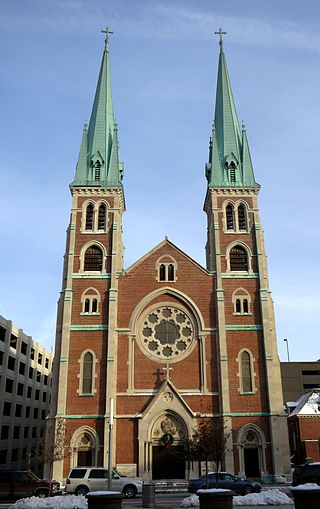
Saint John the Evangelist Catholic Church is a Roman Catholic parish of the Archdiocese of Indianapolis in Indianapolis, Indiana, United States. The parish's origins date to 1837, when it was first named Holy Cross parish. In 1850 it was renamed Saint John the Evangelist parish, and is the oldest Catholic parish in the city and in Marion County, Indiana. Considered the mother of the Catholic parishes in Indianapolis, it played an important role in development of the Catholic Church in the city. Saint John's Church served as the pro-cathedral of the diocese from 1878 until 1906; its rectory served as the bishop's residence and chancery from 1878 until 1892. In 1900 the church served as the site of first episcopal consecration held in Indianapolis.

The Bethel A.M.E. Church, known in its early years as Indianapolis Station or the Vermont Street Church, is a historic African Methodist Episcopal Church in Indianapolis, Indiana. Organized in 1836, it is the city's oldest African-American congregation. The three-story church on West Vermont Street dates to 1869 and was added to the National Register in 1991. The surrounding neighborhood, once the heart of downtown Indianapolis's African American community, significantly changed with post-World War II urban development that included new hotels, apartments, office space, museums, and the Indiana University–Purdue University at Indianapolis campus. In 2016 the congregation sold their deteriorating church, which will be used in a future commercial development. The congregation built a new worship center at 6417 Zionsville Road in Pike Township, Marion County, Indiana.
The following is a timeline of the history of the city of Indianapolis, Indiana, United States.
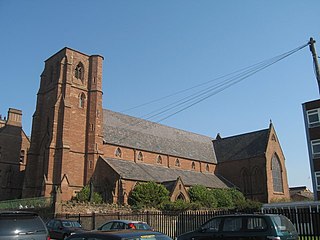
St Anne's Church is in Overbury Street, Edge Hill, Liverpool, Merseyside, England. It is an active Roman Catholic parish church in the Archdiocese of Liverpool. In 1999 its parish was combined with that of the Church of St Bernard. The church is recorded in the National Heritage List for England as a designated Grade II listed building.

The Church of St Mary of the Assumption is in Yorkshire Street, Burnley, Lancashire, England. It is an active Roman Catholic parish church in the diocese of Salford. The church is recorded in the National Heritage List for England as a designated Grade II listed building. It was built between 1846 and 1849 to replace a smaller chapel on a different site. The church was designed by Weightman and Hadfield in Decorated style, and a chapel was added to it in 1879.
Diedrich Augustus Bohlen a native of Cadenberge, Kingdom of Hanover, immigrated to the United States around 1851 and founded D. A. Bohlen, Architect, in 1853 at Indianapolis, Indiana. In 1971 it became Bohlen, Meyer, Gibson and Associates, and is among the oldest architectural firms in the United States still in operation. Bohlen is best known for introducing the German Neo-Gothic architecture style to Indiana. Bohlen and his firm specialized in institutional projects, especially civic, religious, and educational buildings. More than forty of the firm's projects are listed on the National Register of Historic Places, including several of D. A. Bohlen's designs: Morris-Butler House (1864); Saint John the Evangelist Catholic Church (1871), its rectory (1863), and bishop's residence (1878); Indianapolis's Roberts Park Methodist Church (1876) and Crown Hill Cemetery's Gothic Chapel (1877); and in collaboration with his son, Oscar D. Bohlen, the Indianapolis City Market (1886). The combined campus of Saint Mary-of-the-Woods College and the Sisters of Providence of Saint Mary-of-the-Woods make up the Saint Mary-of-the-Woods Historic District, the largest cohesive collection of Bohlen buildings. The District is of statewide significance on the National Register of Historic Places, for its contribution to architectural, educational and religious history.

Roberts Park Methodist Episcopal Church, whose present-day name is Roberts Park United Methodist Church, was dedicated on August 27, 1876, making it the oldest church remaining in downtown Indianapolis. Diedrich A. Bohlen, a German-born architect who immigrated to Indianapolis in the 1850s, designed this early example of Romanesque Revival architecture. The church is considered one of Bohlen's major works. Constructed of Indiana limestone at Delaware and Vermont Streets, it has a rectangular plan and includes a bell tower on the southwest corner. The church is known for its interior woodwork, especially a pair of black-walnut staircases leading to galleries (balconies) surrounding the interior of three sides of its large sanctuary. The church was added to the National Register of Historic Places on August 19, 1982. It is home to one of several Homeless Jesus statues around the world, this one located behind the church on Alabama Street.

The Propylaeum, also known as the John W. Schmidt House or as the Schmidt-Schaf House, is a historic home and carriage house located at 1410 North Delaware Street in Indianapolis, Marion County, Indiana. The Propylaeum was named after the Greek word "propýlaion," meaning "gateway to higher culture." The property became the headquarters for the Indianapolis Woman's Club in 1923, as well as the host for several other social and cultural organizations. It was initially built in 1890-1891 as a private residence for John William Schmidt, president of the Indianapolis Brewing Company, and his family. Joseph C. Schaf, president of the American Brewing Company of Indianapolis, and his family were subsequent owners of the home.
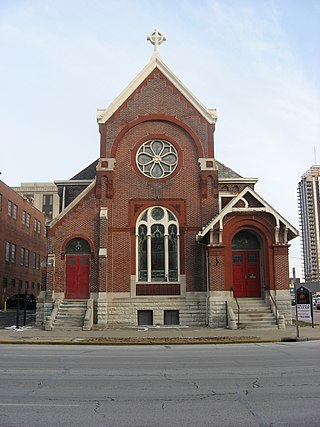
Mount Pisgah Lutheran Church, also known in its early years as the First Lutheran Church and First English Lutheran Church and more recently as The Sanctuary on Penn, is located at 701 North Pennsylvania Street in downtown Indianapolis, Indiana. The historic church was built by the city's first Lutheran congregation, which organized in 1837, and was its third house of worship. The former church, whose present-day name is The Sanctuary on Penn, is operated as a for-profit event venue.























